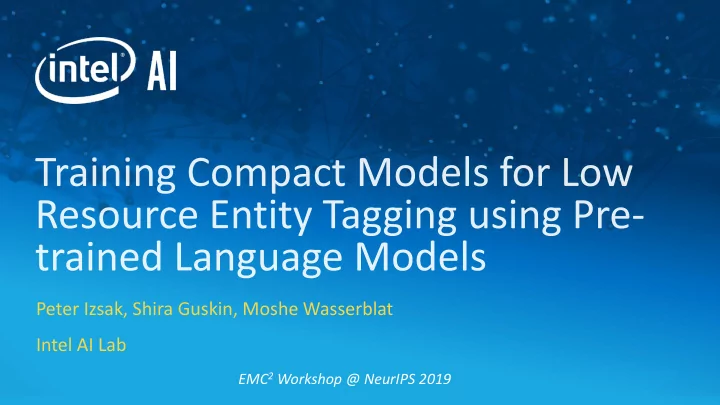

Peter Izsak, Shira Guskin, Moshe Wasserblat Intel AI Lab EMC 2 Workshop @ NeurIPS 2019
Motivation • Named Entity Recognition (NER) is a widely used Information Extraction task in many industrial applications and use cases • Ramping up on a new domain can be difficult ▪ Lots of unlabeled data, little of no labeled data and often not good enough for training a model with good performance Solution A ? Hire a linguist or data scientist to tune/build model ? Hire annotators to label more data or buy similar dataset ? Time/compute resource limitations Solution B ? Pre-trained Language Models such as BERT, GPT, ELMo are great at low-resource scenarios ? Require great compute and memory resources and suffer from high latency in inference ? Deploying such models in production or on edge devices is a major issue This Photo by Unknown Author is licensed under CC BY 2
Enhancing a Compact Model • Approach: • Train a compact model (3M parameters) using a large pre-trained • Pre-trained word embeddings (non-shared embeddings) • Utilize labeled and unlabeled data: • Knowledge Distillation • Pseudo-labeling 3
Model training setup Unlabeled examples Models Teacher Model • Teacher – BERT-base/large (110M/340M params.) KL Divergence • Compact – LSTM-CNN with Softmax/CRF (3M params.) soft targets Distillation Loss Low-resource Dataset Simulation Labeled examples • CoNLL 2003 (English) – PER/ORG/DATE/MISC pseudo-labels • Generate random training sets with labeled/unlabeled examples Compact Model • Train set size: 150/300/750/1500/3000 labels soft targets Task Loss • Report averaged F1 (20 experiments per train set size) annotated labels Integrated model knowledge distillation and Training procedure pseudo-labeling in loss function 1. Fine-tune BERT with labeled data 2. Train compact model using modified loss CrossEntropy( ො 𝑧, 𝑧) 𝑚𝑏𝑐𝑓𝑚𝑓𝑒 𝑓𝑦𝑏𝑛𝑞𝑚𝑓 𝑀 𝑢𝑏𝑡𝑙 = ቊ CrossEntropy (ො 𝑧, ො 𝑧 𝑢𝑓𝑏𝑑ℎ𝑓𝑠 ) 𝑣𝑜𝑚𝑏𝑐𝑓𝑚𝑓𝑒 𝑓𝑦𝑏𝑛𝑞𝑚𝑓 𝑀 𝑒𝑗𝑡𝑢𝑗𝑚𝑚𝑏𝑢𝑗𝑝𝑜 = KL(𝑚𝑝𝑗𝑢𝑡 𝑢𝑓𝑏𝑑ℎ𝑓𝑠 ||𝑚𝑝𝑗𝑢𝑡 𝑑𝑝𝑛𝑞𝑏𝑑𝑢 ) 𝑀𝑝𝑡𝑡 = 𝛽 ⋅ 𝑀 𝑢𝑏𝑡𝑙 + 𝛾 ⋅ 𝑀 𝑒𝑗𝑡𝑢𝑗𝑚𝑚𝑏𝑢𝑗𝑝𝑜 , 𝛽 + 𝛾 = 1.0 4
Compact model performance BERT-base as teacher BERT-large as teacher 12.9% 6.1% 18.9% 16% 1 32 64 128 Batch size 1 32 64 128 Batch size Inference speed on CPU 8.1-10.6 85.2-100.4 109.5-123.8 123.6-137.8 Speedup 3.3-4.3 28.6-33.7 40-45.2 49.9-55.6 Speedup 5
Takeaways • Compact models perform equally well as pre-trained LM in low-resource scenarios, and with superior inference speed and with compression rate is 36x-113x vs. BERT • Compact models are preferable for deployment vs. pre-trained LM in such use-cases • Many directions to explore: • Compact model topology – how small/simple can we make the model? • Other NLP tasks, pre-trained LM • Other ways to utilize unlabeled data • Code available in Intel AI’s NLP Architect open source library NervanaSystems/nlp-architect 6
Recommend
More recommend